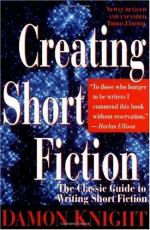
|
| Name: _________________________ | Period: ___________________ |
This test consists of 15 multiple choice questions and 5 short answer questions.
Multiple Choice Questions
1. In what field does Knight specialize ?
(a) Characterization.
(b) Literary devices.
(c) Non-fiction writing.
(d) Short story writing.
2. What was Tolstoy able to do remarkably well?
(a) Create characters.
(b) Create names.
(c) Create plot.
(d) Create setting.
3. What was the first bad habit that Knight had as a teenager?
(a) He would start with one good sentence and not know what to do next.
(b) He did not know how to create a character.
(c) He would start with a weak sentence.
(d) He would create great stories but weak titles.
4. The writer refers to the unconscious mind as ____________.
(a) Frieda.
(b) Franklin.
(c) Fancy.
(d) Fred.
5. Which of the following matches the definition Knight has given for tension?
(a) One plot multiplies into two or three.
(b) Complication of the story.
(c) Setting and character development.
(d) Introducing a new character or setting.
6. What journey does Knight expect writers to take?
(a) Uncreative to dramatically creative.
(b) Mediocre to grand.
(c) Fixated to free.
(d) Amateur to professonal.
7. What can a writer observe to create empathy?
(a) Animals.
(b) Blogs.
(c) People.
(d) Television.
8. Which of the following elements must be present in a story for it to be complete?
(a) Emotion, character.
(b) Character, emotion, situation, clarity.
(c) Character, setting, situation.
(d) Character, setting, situation, emotion.
9. According to Knight, what have many writers never been taught?
(a) How to read.
(b) Why they write.
(c) How to write.
(d) What genre they should write.
10. What does Knight believe is created by interest and energy?
(a) Conflict.
(b) Tension.
(c) Character development.
(d) Plot.
11. Which book did Vonda McIntyre gain inspiration from for Dreamsnake?
(a) A family member's journal.
(b) Harry Potter.
(c) Encyclopedia Britannica.
(d) Dictionary.
12. Which of the following does Knight not say a writer must learn to do when writing a story?
(a) Hear.
(b) See.
(c) Remember.
(d) Accept.
13. Which of the following is an example of learning to see?
(a) Using details.
(b) Remembering dates.
(c) Having knowledge.
(d) Accepting the past.
14. What should emerge once a story evolves, according to Knight?
(a) Tension.
(b) Setting.
(c) Plot.
(d) Theme.
15. What stage of the developing writer will the writer get out of if he or she develops the main character?
(a) Stage 2.
(b) Stage 4.
(c) Stage 1.
(d) Stage 3.
Short Answer Questions
1. Which of the following can be used as inspiration?
2. What does Knight know he cannot pump into people?
3. When the hero is perfect, what does the story lack?
4. Which of the following dialogues have been known to spark an idea for a story?
5. What is the second stage of a developing writer?
|
This section contains 425 words (approx. 2 pages at 300 words per page) |

|




